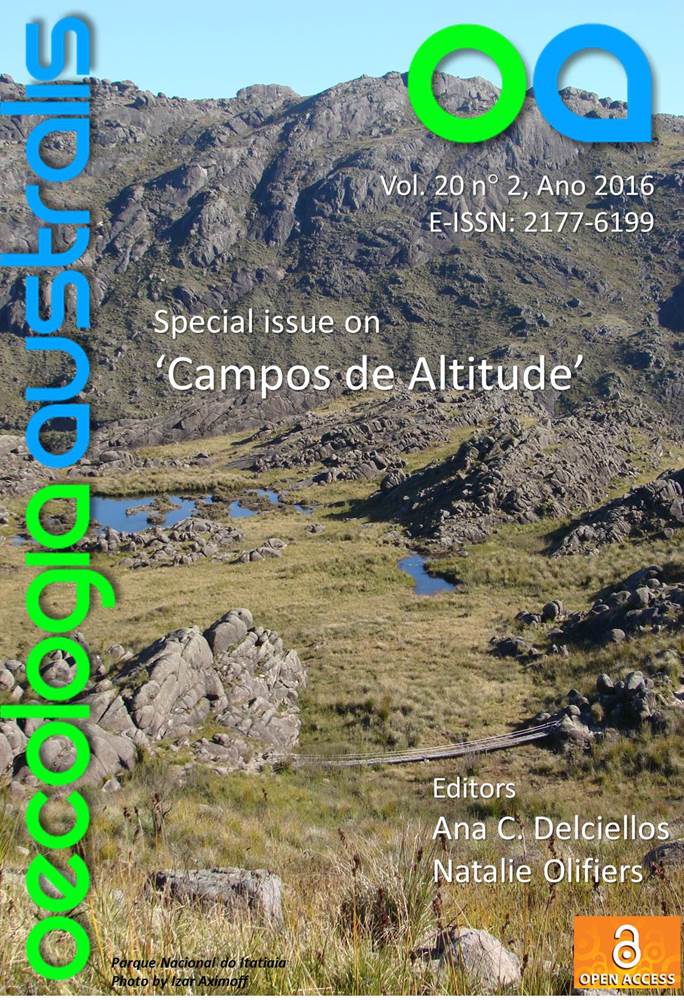COMPOSITION, BODY-SIZE STRUCTURE AND BIOMASS OF ZOOPLANKTON IN A HIGH-ELEVATION TEMPORARY POND (MINAS GERAIS, BRAZIL)
DOI:
https://doi.org/10.4257/oeco.2016.2002.06Keywords:
Iron Quadrangle, Mountain, Shallow lake, Zooplankton communityAbstract
Small ponds are vital inland water bodies, recognized as small repositories of freshwater biodiversity, but neglected in terms of conservation. Although high-elevation ponds are difficult to sample and monitor, it is important to extend their study, in view of their importance to aquatic biodiversity. The aim of this study was to analyze the composition, size structure biomass and diversity of zooplankton community in a temporary pond (Lagoa Seca) of a low-alpine area in the southern part of Serra do Espinhaço mountain in Minas Gerais State, Brazil. Three ecological aspects were analyzed: (I) the taxonomic composition of the zooplankton assemblage, (II) the size structure and biomass of the main groups in the zooplankton community and (III) whether the morphometric characteristics and biomass of the zooplankton result from the dominance of the microzooplankton, as expected in habitats subjected to frequent and strong disturbances, such as temporary ponds. Zooplankton samples were taken during the rainy period (OcÂtober 2010 to January 2011) in different mesohabitats, from the shallowest areas covered by emergent macrophytes to the open water area covered mainly by submerged macrophytes. The zooplankton community consisted of a small number of taxa (29). Rotifera showed the highest richness, with 21 taxa recorded, of which the most constant species were the cosmopolitan Lecane lunaris, L. obtusa and Lepadella patella. Among the Cladocera, Bosmina freyi and Moina minuta were the pelagic species recorded. The other cladoceran species observed are associated with littoral vegetation, and represented mainly by Alona ossiani, Chydorus pubescens, Ephemeroporus tridentatus and Ilyocryptus spinifer. The zooplankton biomass was very low (the maximum dry weight, observed at the peak of the rainy period in January was 62 ?g.m-3). The zooplankton community was dominated by the microzooplankton, with the maximum body length below 900 ?m. This assemblage was very changeable in the short term, both in numerical density and size structure, probably because of the highly variable hydrological regime of the pond. The results from zooplankton composition, including the first record of the rotifer Microcodon clavus to Minas Gerais state and the second in Brazil, highlighted the important role that high-elevation temporary ponds can play as aquatic biodiversity reserves. These unique ecosystems deserve greater efforts of research and monitoring, including studies of their hydrological patÂterns, biological diversity, and adaptive mechanisms of the zooplankton community.
Downloads
Downloads
Additional Files
- camiladebarros, Carta de apresentação e concordância dos autores.pdf (Português (Brasil))
- camiladebarros, 1014-6655-2-carta aos revsores.doc (Português (Brasil))
- camiladebarros, figure 3.tif (Português (Brasil))
- camiladebarros, figure 4.tif (Português (Brasil))
- camiladebarros, figure 5.tif (Português (Brasil))
- camiladebarros, figure 6.tif (Português (Brasil))


